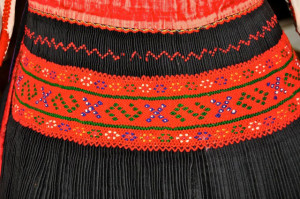FOLKART OF KALOTASZEG

Kalotaszeg is a Hungarian folklore region located in Transylvania and consists of 34 villages. Hungarian Kalotaszeg was annexed to Rumania in 1920 (Peace Treaty of Trianon). The folkart of this region is extraordinarily rich. Every man is a born wood-carver and carpenter. There are also many furriers and hat-makers. They have several types of folk embroideries, but especially their mighty written embroideries are well-known far beyond their borders.
Kalotaszeg embroidery is the most powerful and most serious of all Hungarian peasant embroideries. These ancient embroidery designs have something solemn about them. Their monumental design and braid-like embroidery on crepe-linen distinguishes them from others. The free flowing design is embroidered after a pattern. The pattern is first drawn onto the fabric with a goose feather dipped in water mixed with soot. This type is called “embroidery after writing” or “written embroidery” (írásos), as the design is first written on the material by a “Writing-Woman”. These writing-women draw hundreds of patterns free hand from memory for half their village.
The stitches used belong to the “Chain-Stitch” family and are called: Small or Large Square Chain Stitch, Open Chain Stitch or Braid Stitch. The embroideries are done in red, blue, black or white colored wool or heavy cotton yarn.
The patterns of these free design embroideries are very divers. Stylized floral motives dominate, but designs with names such as sun, moon and star prove that the people of Kalotaszeg still follows ancient traditions by using astronomical shapes. Among the patterns we also find the tree of life, numerous shapes of the tulip and the rose.
Embroidery is used on pillow ends, bed-covers, sheet-ends, wall-hangings, towels, engagement kerchiefs, table-cloths, but before all on folk costumes. It is a constant surprise how skillfully the Kalotaszeg woman uses the many types of embroidery on her dress, the most elegant Hungarian folk costume.
